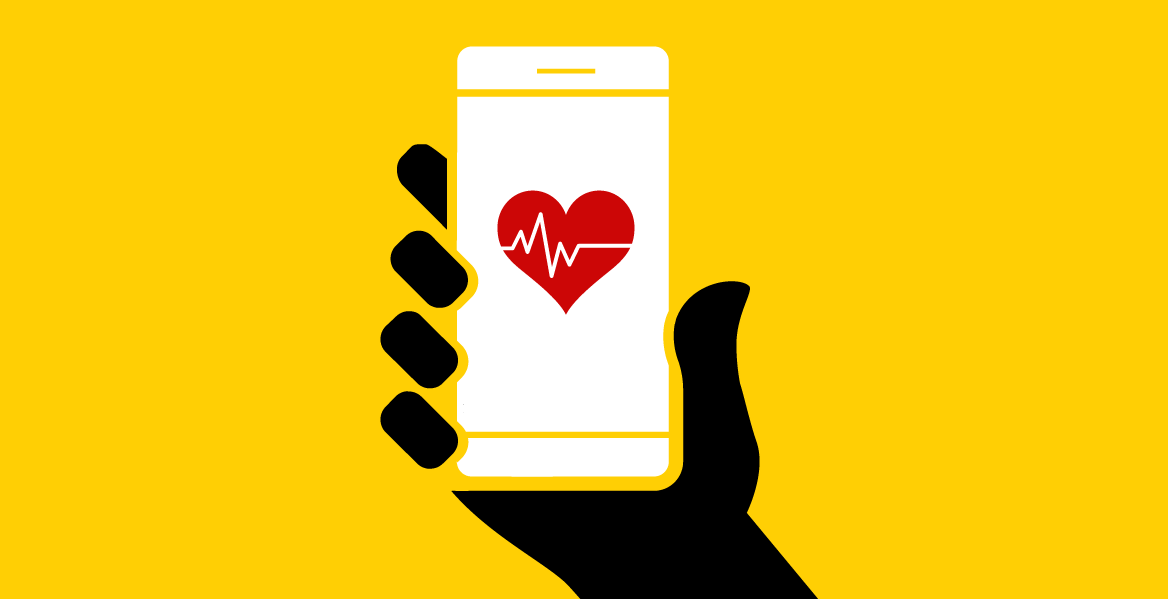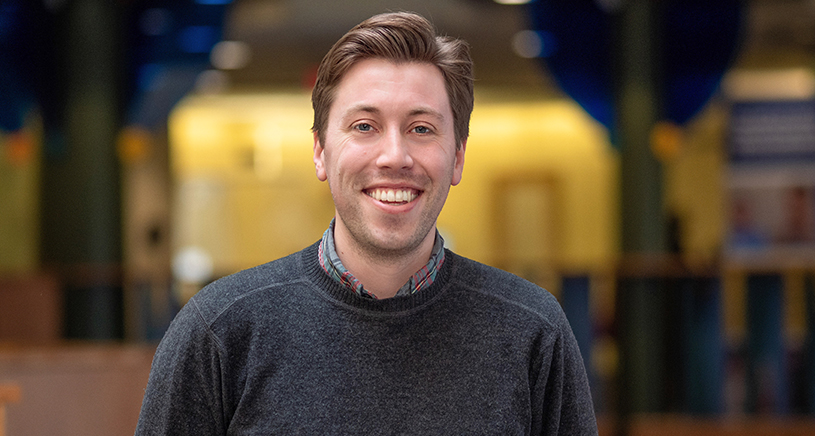Mobile Health: Supporting Your Health Beyond the Clinic

How are public health professionals implementing mobile devices, smartphone apps, and texting to create health management plans?
Experts from the University of Michigan School of Public Health discuss the latest research on mobile health and how smartphones apps and texting programs can help improve the health of individuals and populations around the globe—from supporting smoking cessation programs to helping people manage their diabetes.
Listen to "Mobile Health: Supporting Your Health Beyond the Clinic" on Spreaker.
|
Subscribe and listen to Population Healthy on Apple Podcasts, Spotify, Google Podcasts, iHeartRadio, YouTube or wherever you listen to podcasts! Be sure to follow us at @umichsph on Twitter, Instagram, and Facebook, so you can share your perspectives on the issues we discussed, learn more from Michigan Public Health experts, and share episodes of the podcast with your friends on social media. |
[music]
00:03 Host: The term is used in a variety of ways, what we typically mean by mobile
health is communicating directly with patients using their cell phones between face-to-face
visits with their doctor.
00:14 Walter Dempsey: One of the critiques of mobile health and mobile interventions
is people see them and say, "Well it's just a message to your phone. How effective
can that be?" And I think one of the important things to realize is that these interventions
are trying to be provided in moments of need in the natural environment of the person.
So of course, if I just send you a ping on your phone, and it's random throughout
the day, and it's someone who doesn't need help, it's just like a text message you
might ignore it. But I do think we should be cognizant of the fact that these are
people who need help and are motivated and so you're going to have these interventions
potentially have an effect because you're providing them in the right moments.
00:57 Host: There's a good chance you're listening to this podcast on your cell phone
and while you're hearing my voice, there's a good chance you have health promoting
apps running as well. You might use one to meditate during stressful workdays, to
keep track of the calories you're consuming, or to help train for that 5K next month.
But you may not realize that today, public health professionals are using these same
technologies to create highly tailored health management tools to care for some of
the most vulnerable populations in our communities. Mobile health interventions, used
as part of a treatment plan are proving to be some of the most successful health interventions
among high risk chronically ill people. Hello and welcome to population healthy a
podcast from the University of Michigan School of Public Health, join us as we dig
into important public health topics, stuff that affects the health of all of us, at
a population level, from the microscopic to the macro-economic, the social to the
environmental from neighborhoods to cities, states, to countries and around the world.
[music]
02:07 Host: John Piette is a professor in the Department of Health Behavior and Health
Education here at the University of Michigan School of Public Health. He's also the
director of the Center for Managing Chronic Disease. He's been developing and implementing
mobile health programs for over a decade.
02:22 John Piette: We really focus on developing mobile health strategies to support
some of the most vulnerable communities in managing their chronic illnesses. Sometimes
when we talk about fancy technology or cell phone-based interventions, people tend
to have the bias that people who are lower income, who maybe are illiterate have limited
education, either won't participate in these programs or won't be able to because
they just don't have the skills. What we have found is that exactly the opposite is
true, when people are lacking access to care, when they're struggling with knowing
how to manage their chronic disease, they're very motivated to participate in a program,
such as the ones we develop. People with depression in Bolivia have told us in qualitative
interviews the meta message, the message they get, just by receiving that contact
is that someone somewhere cared enough about them to develop a program to help them
stay well. And that in and of itself is very, very therapeutic to people. It gives
them often the strength and encouragement to kind of keep going despite their struggles.
03:32 JP: And that's really often their motivation for continuing to be engaged with
the programs we develop. Latin America is really the ideal sort of environment to
have an impact with mobile health. First, like almost everywhere in the world, people
do have phones. And increasingly they actually have smartphones. Even in low-income
communities, people tend to have cellular phones that they're carrying around in their
pocket. Access to care and health outcomes are often quite poor in many areas of Latin
America, and so we can really have the impact by taking what we've learned, and using
this new communication channel to reach people between face-to-face encounters with
their provider and really make a big difference in their health behavior and in their
health outcomes.
04:19 JP: A lot of patients have a number of different barriers to doing self-care.
Chronic disease management, even if you're not economically challenged is complicated
for everyone. People with diabetes have to do a wide range of things to avoid complications
and stay well. They have to check their feet, and if they're smoker, they should try
to stop. They have to manage their weight, they have to manage their diet, they have
to take medications, they have visits with their doctors. So organizing that, in the
context of day-to-day life is hard for everyone. And mobile health communication can
take the type of education that we typically give in big doses when patients come
in to see their doctor or a health educator and we can break that education down into
bite-sized doses that people can really take better advantage of.
05:11 JP: We can send people reminders to take their medications, we can monitor their
status and make sure we're sending them educational messages that makes sense, given
how they're doing. It's a number of different goals that we have. First and foremost,
is to really learn first-hand from the people there what their situation is like,
and what they really need. So being on the ground and actually talking to people who
are struggling with chronic disease, is essential. You simply can't do it at a distance.
We're always trying to build trust and to let them know that our main goal is to help
them live well and develop interventions that work for them. Trust building isn't
something that happens overnight. Finally, we have to work with people to develop
the specific content of these mobile health communications so that they really make
sense to them and address their needs in a language and a way of communicating that
they really understand, and can use. When you deal with people with chronic disease,
especially when you do it globally, like we do, it's not a one-size-fits-all, people
can be really really different. And part of the benefit of being here in the School
of Public Health is that we work on a one-to-one collaborative equal basis with all
these people to understand where they're coming from and so that we can design programs
that really help them.
[music]
06:33 JP: And Mi-REP is a great example of the type of collaborations that we'd like
to have here at the, UM School of Public Health. Mi-REP stands for the Michigan Re-entry
Program. In this case, all of the groups are coming together to help people that are
being released from jails, usually county jails around the state of Michigan. The
project includes the head of Behavioral Health and Forensics at the Michigan Department
of Health and Human Services, the Center for Behavioral Health and Justice at Wayne
State University, as well as colleagues at the University of Massachusetts. People
that are being released from the jails are at great risk of several bad outcomes.
They have a very high prevalence of substance abuse disorders, often opioid abuse
disorders, as well as serious mental health challenges. And as a result of those problems
when they come out they're at risk for homelessness, they're at risk for overdose,
they're at risk for suicide, and they're at risk for committing crimes that will land
them back in the system.
07:42 JP: When people get out of jail, they have someone who has their back, that
is their case manager. As much as those people care, and as much as they help, they
can't be their day-to-day when people have crisis. We're developing some mobile health
tools so that we can monitor recently released inmates cravings for drugs, we can
monitor their mental health symptoms, and we can ask them if they've been maintaining
contact with their case manager. 'cause those three things, drug cravings, mental
health, and connection with their case manager will tell you a lot about who's at
risk for having a problem. We hope that we can make the Mi-REP program that much more
effective and help these people reintegrate in society, get that job, maintain stable
housing, and have the better outcomes that they deserve. There's no question in my
mind that people who are coming out of that situation, that have the dual diagnosis
of mental health or psychiatric disorders and substance abuse disorders, they know
they're at risk, they want to stay well and frankly they're often scared. Overdose
is a very real risk. Many people come out of the jails and prisons and they die within
the first high risk period, the first two to four weeks after being released.
08:58 JP: So they're very motivated to have the type of connection with the programs
we're developing 'cause they want to stay well and they want their care manager to
be able to reach in and give them support if they need additional assistance. The
good news, bad news is that we have hundreds, thousands of studies showing that text
messaging programs, specialized apps, chronic disease-focused games can make a big
difference in people's health behavior and their health outcomes. The bad news is
that even despite all of the scientific evidence most people that are out in the real
world don't have these programs as part of their usual care. So that's really the
big challenge for this field I feel at this point, it's figuring out how to take what
we already know works, and get it out there in the real world at scale.
[music]
09:54 Host: Getting these programs out into the world means getting them into the
hands of real people and that means continually emphasizing the human connection into
automated technology. Nicolle Marinec, the Associate Managing Director of the Center
for Managing Chronic Disease, and the University of Michigan School of Public Health
alum explains the power of people-centered technology.
10:14 Nicolle Marinec: Mobile health, let us meet people where they are. We're kind
of always pushing the envelope, thinking how can we make it better? One of our staff
members is someone who works in reinforcement learning and artificial intelligence,
and that's a really cool thing that I think is helping improve mobile health interventions
because it's allowing us to tailor people's experiences with these interventions and
saying, "What's the best type of content for you? Should we give you a funny message?
Should we give you something that maybe is very educational? What's the best type
of message that's gonna help them move the dial forward for themselves?" With artificial
intelligence, we can try to figure out what are the best treatment methods for people?
How intensive should it be? Should we triage people who exhibit certain characteristics
during their intervention? I think sometimes we don't realize how different some people's
realities are from our own. And so the very automated call that one person may dislike
is a lifeline to someone else. So years ago, I called a participant to recruit them
for a study, so they enrolled. And then three months later, I called them back to
do the follow-up survey.
11:20 NM: And when they answered the phone [chuckle] I'll never forget, they said,
"Hey Nicolle, how are you?" I had to do a double take, because I was at work, I was
calling them from a work general phone number. There was no way they could have known
it was me, so I asked, I said, "Wow, it's good to hear your voice. Nice to talk to
you. But how did you know it was me?" And their response gave me pause because they
said, "You're the only person who calls me, so I knew it had to be you." And I thought,
"I'm the only person that calls you." And that was just three months ago, it was a
reality check. For so many different reasons, I realized people don't have strong
social support, because maybe they live far from their family or far from anyone.
They may have anxiety or PTSD, they physically may be unable to get out of their house
without assistance. Our programs give people a chance to be free of some of those
issues, and maybe we focus on themselves a little bit in a different way than they
have previously.
[music]
12:18 Host: Programmers create the apps that go on your devices, but before they get
started, there's a lot of research that goes into making sure these apps are scientifically
sound user-centered programs.
12:28 Walter Dempsey: My name is Walter Dempsey I'm an Assistant Professor of Biostatistics
at the University of Michigan School of Public Health, I'm also an Assistant Research
Professor at the Institute of Social Research. My role as a biostatistician in mobile
health is to work on translating scientific questions into the design and analysis
of trials. The goal there is to figure out what to do in different contexts and use
mobile information collected via wearables and mobile devices to understand how to
treat individuals in their real life. One example of a mobile health study is the
Sense to Stop, which is a smoking cessation study, this is a study in which individuals
are wearing multiple devices, so they're wearing a chest band, and two wristbands
to collect sensor information on them. Someone who is trying to quit smoking, they're
going about their daily life, and they're kind of stressed out, they're trying to
balance both quit smoking as well as working in their job or they're going to school.
And so a lot of the times stress will lead to a risk of relapse. And the question
that behavioral scientists are interested in answering is, when should we provide
reminders, to practice mindfulness to reduce stress and therefore reduce risk of lapse?
13:40 WD: We can think of someone at baseline, when they just decide to quit smoking
their highly motivated and so these reminders might have a huge impact on reducing
stress and therefore reducing risk of lapse, but 10 days out, they might not have
the same effect. So, we're not only interested in answering what is the effect of
these messages, but also what is the effect and how does it vary over time? There
are many goals when running one of these mobile health studies. Obviously, the most
important is to answer the scientific question but we're trying to then use these
interventions in real life, and in the real world, one of the key issues is burden,
and one of the types of burden is just how many sensors can someone wear? In a typical
mobile health study, you're going to have, the wearable typically as low burden as
possible, so hopefully just a wrist sensor as well as the mobile phone collecting
information on the individual. The other type of burden many people are familiar with
is if I download an app on my phone a lot of the times these apps are going to send
you messages or notifications to try and get you used the app.
14:39 WD: And one of the things we're really worried about is providing too many interventions
over the course of the study, and therefore having too much user burden and having
the worst outcome which is, the individual deleting the app. What we're trying to
do in these studies is figure out a way to maximize therapeutic effects of these messages
while minimizing user burden. And there's two types of messages: There's therapeutic
interventions you might send, and engagement-based interventions. So a therapeutic
message is exactly like in Sense to Stop where you have reminders to practice mindfulness
or in the physical activity study its messages around trying to get them to walk.
In a study I'm involved with called Heart Steps, we actually tailor the therapeutic
messages around physical activity to your current context. So for example, one of
the things that might annoy a person in the study is if you ask them to go for a walk
outside, and it's currently raining. So what we do is we take into account your current
location. We look at the weather, and if it's nice enough outside, we might suggest
you go for a walk outside. So one of the messages was something along the lines of,
"Go for a walk until you see the first squirrel."
15:46 WD: So they are cute, they're fun, and they try and get you engaged as well.
But the main point here is they're tailored to your current context, and they're trying
to have a therapeutic effect by trying to get you to walk. So mobile health is useful
in a variety of context for a variety of diseases. The ones I've worked mostly on
are trying to increase physical activity for individuals who just had a cardiac event
or in pre-op situations where you're trying to increase overall physical activity.
I've also worked in different issues, such as in mental health and suicide. There
we're trying to use wearable devices to collect information to try and time when to
provide interventions to try and promote social interactions. In this recent study
that we're just started the individuals are providing self-reports of suicidal ideation
over time, and the goal is to try and get them to implement their safety protocols,
if they reach certain levels of ideation. And the nice thing is mobile health provides
a way to reach out just in time as opposed to waiting for them to come back into the
hospital or into primary care.
[music]
16:55 Host: Thanks for listening to this episode of Population Healthy from the University
of Michigan School of Public Health. We're glad you decided to join us, and we hope
you learned something that will help improve your own health or make the world a healthier
place. If you enjoyed the show, please subscribe or follow this podcast on iTunes,
Apple podcasts, Google Play, Stitcher, Spotify or wherever you listen to podcasts.
Be sure to follow us at UM ICH SPH on Twitter, Instagram, and Facebook, so you can
share your perspectives on the issues we discuss, learn more for Michigan public health
experts and share episodes of the podcast with your friends on social media. You can
also check out the show notes on our website, publichealth.unich.edu/podcast for more
resources about the topics discussed in today's episode. If you want to stay up to
date with the latest research and expertise from Michigan Public Health subscribe
to our Population Healthy newsletter at publichealth.umich.edu/news/newsletter. We
hope you can join us for next week's episode. Where we'll dig further into public
health topics that affect all of us at a population level.
In This Episode
 Walter Dempsey
Walter Dempsey
Assistant Professor of Biostatistics at the University of Michigan School of Public
Health and Assistant Research Professor at the Institute for Social Research
Walter Dempsey’s research focuses on statistical methods for digital and mobile health.
His current work involves three complementary research themes: experimental design
and analytic methods to inform multi-stage decision making in health; statistical
modeling of complex longitudinal and survival data; and statistical modeling of complex
relational structures like interaction networks. Learn more.
 John Piette
John Piette
Professor of Health Behavior and Health Education at the University of Michigan School
of Public Health
A global leader in innovation for chronic disease self-management support, John Piette’s
work focuses on improving access to quality self-management support among patients
with a variety of chronic conditions including diabetes, cardiovascular disease, depression,
and chronic pain. His work includes developing mobile health interventions designed
to improve patient health monitoring and assistance with behavior changes. Learn more.
 Nicolle Marinec
Nicolle Marinec
Associate Managing Director, Center for Managing Chronic Disease (CMCD) at the University of Michigan School of Public Health and VA Ann Arbor
Nicolle Marinec has coordinated the development efforts of the CMCD’s integrated mobile health platform for over 13 years, helping investigators and clinicians develop patient outreach and support programs in the United States and globally throughout Latin America, Europe and Thailand. One area of Marinec’s expertise is leveraging Omni-channel, including tools like Interactive Voice Response (automated telephone calls), SMS (text messaging), chat bots and web-portals to design tailored programs for researchers and clinicians while being mindful of culture and literacy to design appropriate tools.
